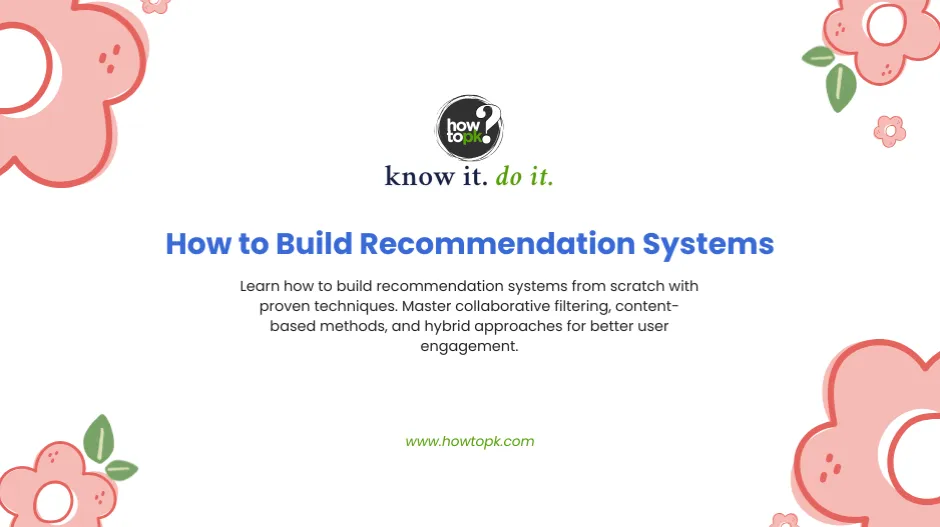In today’s data-driven world, knowing how to build recommendation systems has become one of the most valuable skills in technology. These intelligent systems power everything from Netflix’s movie suggestions to Amazon’s product recommendations, driving billions in revenue annually.
When you build recommendation systems effectively, you’re not just creating algorithms—you’re crafting personalized user experiences that can dramatically increase engagement, retention, and conversion rates. Companies that implement sophisticated recommendation engines see average revenue increases of 10-30%.
This comprehensive guide will walk you through everything needed to build recommendation systems from the ground up, covering essential algorithms, implementation strategies, and best practices used by industry leaders.
Understanding the Foundation: What Are Recommendation Systems?
Before diving into how to build recommendation systems, it’s crucial to understand their core purpose. Recommendation systems are intelligent algorithms designed to predict and suggest items that users might find interesting based on their past behavior, preferences, and similarities to other users.
These systems solve the information overload problem by filtering through vast amounts of data to present users with personalized, relevant content. When you build recommendation systems correctly, they become powerful tools for enhancing user satisfaction while driving business metrics.
Types of Recommendation Approaches
There are three primary approaches when you build recommendation systems:
- Content-Based Filtering: This method recommends items similar to those a user has previously liked, based on item features and characteristics.
- Collaborative Filtering: This approach suggests items based on the preferences of similar users, leveraging the “wisdom of crowds” principle.
- Hybrid Methods: These combine multiple approaches to overcome individual limitations and provide more accurate recommendations.
Step 1: Content-Based Recommendation Systems
How Content-Based Systems Work
When you build recommendation systems using content-based filtering, you focus on item attributes and user preferences. This method analyzes the features of items users have interacted with and recommends similar items.
For example, if you’re building a movie recommendation system and a user enjoys action movies starring specific actors, the system will recommend other action films with similar cast members or themes.
Implementation Steps for Content-Based Systems
Step | Process | Key Considerations |
1 | Feature Extraction | Identify relevant item attributes (genre, category, keywords) |
2 | User Profile Creation | Build user preference vectors based on interaction history |
3 | Similarity Calculation | Use cosine similarity or Euclidean distance |
4 | Recommendation Generation | Rank items by similarity scores |
Code Implementation Example
import pandas as pd
from sklearn.feature_extraction.text import TfidfVectorizer
from sklearn.metrics.pairwise import cosine_similarity
def build_content_based_recommender(items_df, user_interactions):
# Create TF-IDF vectors for item features
tfidf = TfidfVectorizer(stop_words='english')
item_vectors = tfidf.fit_transform(items_df['combined_features'])
# Calculate similarity matrix
similarity_matrix = cosine_similarity(item_vectors)
# Generate recommendations
def get_recommendations(item_id, num_recommendations=10):
item_idx = items_df[items_df['id'] == item_id].index[0]
similarity_scores = list(enumerate(similarity_matrix[item_idx]))
similarity_scores = sorted(similarity_scores, key=lambda x: x[1], reverse=True)
recommended_items = []
for i, score in similarity_scores[1:num_recommendations+1]:
recommended_items.append(items_df.iloc[i]['id'])
return recommended_items
return get_recommendations
Step 2: Collaborative Filtering Implementation
Understanding Collaborative Filtering
Collaborative filtering is one of the most popular methods to build recommendation systems because it leverages user behavior patterns without requiring detailed item metadata. This approach identifies users with similar preferences and recommends items that similar users have enjoyed.
There are two main types of collaborative filtering:
- User-Based Collaborative Filtering: Finds users similar to the target user and recommends items those similar users have liked.
- Item-Based Collaborative Filtering: Identifies items similar to those the user has interacted with and recommends accordingly.
Matrix Factorization Techniques
When you build recommendation systems at scale, matrix factorization becomes essential. Techniques like Singular Value Decomposition (SVD) and Non-negative Matrix Factorization (NMF) help decompose user-item interaction matrices into lower-dimensional representations.
These methods are particularly effective because they can:
- Handle sparse data efficiently
- Capture latent factors in user preferences
- Scale to millions of users and items
- Provide interpretable recommendation explanations
Implementation with Matrix Factorization
from sklearn.decomposition import NMF
import numpy as np
def build_collaborative_filtering_system(user_item_matrix):
# Apply NMF for matrix factorization
model = NMF(n_components=50, random_state=42)
user_features = model.fit_transform(user_item_matrix)
item_features = model.components_
# Reconstruct the matrix for predictions
predicted_ratings = np.dot(user_features, item_features)
def get_user_recommendations(user_id, num_recommendations=10):
user_idx = user_id
user_ratings = predicted_ratings[user_idx]
# Get items not yet rated by user
unrated_items = np.where(user_item_matrix[user_idx] == 0)[0]
# Sort by predicted rating
recommendations = sorted(
[(item, user_ratings[item]) for item in unrated_items],
key=lambda x: x[1], reverse=True
)
return [item for item, rating in recommendations[:num_recommendations]]
return get_user_recommendations
Step 3: Advanced Hybrid Approaches
Why Hybrid Systems Are Superior
While individual approaches have their strengths, hybrid systems that combine multiple methods typically perform better when you build recommendation systems for real-world applications. They overcome the limitations of single approaches:
- Cold Start Problem: New users or items with no historical data
- Sparsity Issues: Limited user-item interactions in large catalogs
- Diversity Concerns: Avoiding filter bubbles and echo chambers
Popular Hybrid Architectures
- Weighted Hybrid: Combines scores from multiple algorithms using predetermined weights.
- Switching Hybrid: Uses different algorithms based on specific situations or data availability.
- Mixed Hybrid: Presents recommendations from multiple algorithms simultaneously.
- Feature Combination: Merges features from different approaches into a single algorithm.
Deep Learning Integration
Modern recommendation systems increasingly leverage deep learning to build recommendation systems that can capture complex, non-linear relationships. Popular architectures include:
- Neural Collaborative Filtering (NCF): Uses neural networks to model user-item interactions more effectively than traditional matrix factorization.
- Autoencoders: Learn compressed representations of user preferences for improved recommendations.
- Recurrent Neural Networks (RNNs): Capture sequential patterns in user behavior for session-based recommendations.
import tensorflow as tf
from tensorflow.keras import layers, Model
def build_neural_collaborative_filtering(num_users, num_items, embedding_dim=50):
# User and item embeddings
user_input = tf.keras.Input(shape=(), name='user_id')
item_input = tf.keras.Input(shape=(), name='item_id')
user_embedding = layers.Embedding(num_users, embedding_dim)(user_input)
item_embedding = layers.Embedding(num_items, embedding_dim)(item_input)
# Flatten embeddings
user_vec = layers.Flatten()(user_embedding)
item_vec = layers.Flatten()(item_embedding)
# Neural layers
concat = layers.Concatenate()([user_vec, item_vec])
dense1 = layers.Dense(128, activation='relu')(concat)
dense2 = layers.Dense(64, activation='relu')(dense1)
output = layers.Dense(1, activation='sigmoid')(dense2)
model = Model(inputs=[user_input, item_input], outputs=output)
model.compile(optimizer='adam', loss='binary_crossentropy', metrics=['accuracy'])
return model
Step 4: Evaluation Metrics and Testing
Essential Metrics to Track
When you build recommendation systems, proper evaluation is critical for success. Here are the key metrics to monitor:
Accuracy Metrics:
- Mean Absolute Error (MAE)
- Root Mean Square Error (RMSE)
- Precision and Recall
Ranking Metrics:
- Mean Average Precision (MAP)
- Normalized Discounted Cumulative Gain (NDCG)
- Area Under Curve (AUC)
Business Metrics:
- Click-through Rate (CTR)
- Conversion Rate
- User Engagement Time
- Revenue per User
A/B Testing Framework
Testing Phase | Duration | Sample Size | Key Metrics |
Initial Test | 2-4 weeks | 10% of users | CTR, Engagement |
Validation | 4-6 weeks | 25% of users | Conversion, Revenue |
Full Rollout | Ongoing | 100% of users | All metrics |
Step 5: Handling Real-World Challenges
The Cold Start Problem
One of the biggest challenges when you build recommendation systems is handling new users or items with limited data. Several strategies can address this:
For New Users:
- Use demographic-based recommendations
- Implement onboarding questionnaires
- Leverage social media data (with permission)
- Apply popularity-based recommendations initially
For New Items:
- Use content-based features
- Implement expert recommendations
- Apply trending algorithms
- Use editorial curation
Scalability Considerations
As your user base grows, scalability becomes crucial when you build recommendation systems. Consider these architectural patterns:
- Distributed Computing: Use frameworks like Apache Spark for processing large datasets across multiple machines.
- Caching Strategies: Implement Redis or Memcached to store pre-computed recommendations for faster retrieval.
- Real-time vs. Batch Processing: Balance between real-time personalization and computational efficiency.
Privacy and Ethical Considerations
Modern recommendation systems must address privacy concerns and ethical implications:
- Data Minimization: Collect only necessary user data
- Transparency: Provide users with explanation capabilities
- Bias Mitigation: Regularly audit for algorithmic bias
- User Control: Allow users to modify or delete their profiles
Step 6: Production Deployment and Monitoring
Infrastructure Requirements
When you build recommendation systems for production, consider these infrastructure components:
- Data Pipeline: Robust ETL processes for handling user interactions, item catalogs, and external data sources.
- Model Serving: APIs for real-time recommendation delivery with low latency requirements.
- Monitoring Systems: Comprehensive logging and alerting for model performance degradation.
Continuous Learning and Adaptation
Successful recommendation systems continuously learn and adapt:
- Online Learning: Update models incrementally as new data arrives rather than retraining from scratch.
- Multi-Armed Bandits: Balance exploration of new items with exploitation of known preferences.
- Reinforcement Learning: Optimize for long-term user satisfaction rather than immediate clicks.
Advanced Techniques and Future Trends
Graph-Based Recommendations
Graph neural networks are emerging as powerful tools to build recommendation systems that can capture complex relationships between users, items, and contextual information. These methods excel at:
- Modeling multi-hop relationships
- Incorporating side information effectively
- Handling heterogeneous data types
- Providing explainable recommendations
Context-Aware Systems
Modern systems increasingly consider contextual factors when generating recommendations:
- Temporal Context: Time of day, season, recent trends
- Location Context: Geographic preferences and availability
- Social Context: Friends’ activities and social signals
- Device Context: Mobile vs. desktop usage patterns
Best Practices and Common Pitfalls
Implementation Best Practices
When you build recommendation systems, follow these proven practices:
- Start Simple: Begin with basic collaborative filtering or content-based methods before advancing to complex deep learning models.
- Feature Engineering: Invest time in creating meaningful features that capture user intent and item characteristics.
- Regularization: Apply techniques to prevent overfitting and improve generalization.
- Diversity Optimization: Balance relevance with diversity to avoid filter bubbles.
Common Mistakes to Avoid
- Over-Engineering: Don’t immediately jump to complex neural networks when simpler methods might be more effective and maintainable.
- Ignoring Business Objectives: Ensure your recommendation metrics align with actual business goals rather than just technical accuracy.
- Insufficient Data Quality: Poor data quality will undermine even the most sophisticated algorithms.
- Lack of Baseline Comparisons: Always compare your system against simple baselines like popularity-based recommendations.
Tools and Resources for Implementation
Popular Libraries and Frameworks
Several excellent tools can help you build recommendation systems efficiently:
Python Libraries:
- Surprise: Specialized library for collaborative filtering algorithms
- LightFM: Hybrid recommendation algorithm implementation
- TensorFlow Recommenders: Google’s framework for large-scale recommendation systems
- PyTorch Geometric: For graph-based recommendation models
Distributed Computing:
- Apache Spark MLlib: Scalable machine learning library with recommendation algorithms
- Hadoop Ecosystem: For processing large-scale user interaction data
External Resources and Learning Materials
To deepen your understanding of how to build recommendation systems, consider these authoritative resources:
- Academic Papers: “Matrix Factorization Techniques for Recommender Systems” by Koren et al.
- Online Courses: Stanford’s CS229 Machine Learning course covers recommendation fundamentals
- Industry Conferences: RecSys Conference for latest research and industry practices
- Documentation: TensorFlow Recommenders Guide for practical implementation examples
Performance Optimization Strategies
Computational Efficiency
When you build recommendation systems at scale, performance optimization becomes critical:
- Approximate Methods: Use techniques like Locality Sensitive Hashing (LSH) for faster similarity calculations.
- Dimensionality Reduction: Apply PCA or other reduction techniques to decrease computational complexity.
- Sampling Strategies: Use negative sampling and other techniques to train on manageable data subsets.
- Model Compression: Implement knowledge distillation to create smaller, faster models for production.
Real-Time Recommendations
For applications requiring instant recommendations:
- Pre-computation: Calculate recommendations offline and cache results
- Incremental Updates: Update models with streaming data processing
- Edge Computing: Deploy lightweight models closer to users
- API Optimization: Implement efficient serving architectures with proper caching
Measuring Success and ROI
Key Performance Indicators
Track these metrics to measure how effectively you build recommendation systems:
Metric Category | Specific Metrics | Target Ranges |
Engagement | Click-through Rate | 2-8% |
Conversion | Purchase Rate | 1-5% |
Retention | Return Visit Rate | 30-60% |
Satisfaction | Rating Accuracy | >4.0/5.0 |
Business Impact Assessment
Successful recommendation systems demonstrate clear business value:
- Revenue Impact: Track direct sales attributed to recommendations versus other discovery methods.
- User Retention: Monitor how recommendations affect user lifetime value and churn rates.
- Operational Efficiency: Measure reduced customer service load due to better product discovery.
Future Trends and Emerging Technologies
- Conversational Recommendations: The next frontier in how to build recommendation systems involves conversational AI integration. These systems engage users in natural language dialogues to better understand preferences and provide contextual suggestions.
- Federated Learning: Privacy-preserving techniques allow you to build recommendation systems without centralizing sensitive user data, enabling personalization while maintaining user privacy.
- Multimodal Integration: Advanced systems incorporate multiple data types; text, images, audio, and video, to create richer user profiles and more accurate recommendations.
Conclusion: Your Path to Building Effective Recommendation Systems
Learning how to build recommendation systems effectively requires combining theoretical understanding with practical implementation experience. Start with fundamental approaches like collaborative filtering and content-based methods, then gradually incorporate advanced techniques as your expertise grows.
The key to success lies in understanding your specific use case, maintaining high data quality, and continuously iterating based on user feedback and business metrics. Remember that the best recommendation system is one that serves both user needs and business objectives effectively.
Whether you’re working on e-commerce platforms, content streaming services, or social media applications, the ability to build recommendation systems will remain a highly valuable and increasingly important skill in the AI-driven future.
By following the strategies and techniques outlined in this guide, you’ll be well-equipped to create recommendation systems that not only provide accurate suggestions but also drive meaningful business results and enhanced user experiences.











